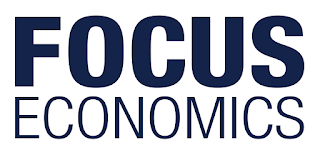
Imran Khan - the newly elected PM of Pakistan - grabs $6B in aid money from MBS led Saudi Arabia. In the Kingdoms current quagmire MBS is no...
$6B In Saudi Aid To Pakistan

The outlook in Turkey has worsened. Economics Recent indicators suggest the economy slowed sharply in the third quarter. Consumer a...
Economic Snapshot For Turkey: In Deterioration
The outlook in Turkey has worsened.
Economics
Looking ahead, economic growth is expected to decelerate. This reflects China’s more mature economic cycle and the impact of previou...
China 2019 Growth Pegged At 6.3%
The People’s Bank of China (PBOC) uses a complex system to implement monetary policy, including the use of key benchmark rates, open market operations and reserve requirement ratios. On 6 October, the Bank announced a cut of 100 basis points to the reserve requirement ratio for most banks, which will release around CNY 750 billion. The move is intended to spur credit growth amid softening economic conditions. Panelists expect that the one-year deposit and lending rates to close 2019 at 1.52% and 4.32% respectively and 2020 at 1.58% and 4.33%
Export growth surges in September despite escalating U.S.-China trade tensions Export growth accelerated from 9.8% in August to 14.5% in September. The reading surprised market analysts as they had expected a slowdown to an 8.9% rise. The surge in export growth likely reflected a hike of the export tax rebate rates for selected products effective 15 September as well as front-loading shipments to the United States before the implementation of additional tariffs on USD 200 billion of Chinese products by the United States on 25 September. Although imports expanded at double-digit figures for the seventh consecutive month, import growth softened from 19.9% in August to 14.3% in September. The print was below the 15.0% rise that market analysts had expected and reflected weaker domestic demand. The trade surplus consequently rose from USD 28.5 billion in September 2017 to USD 31.7 billion in September 2018 (August 2018: USD 27.9 billion). The 12-month moving sum of the trade surplus increased from USD 350 billion in August to USD 355 billion in September. Our panelists forecast that exports will expand 5.7% in 2019 and imports will rise 8.0%, bringing the trade surplus to USD 316 billion. In 2020, FocusEconomics panelists expect exports will expand 2.9%, while imports will rise 5.8%, bringing down the trade surplus to USD 258 billion
Geopolitical tensions are at a boiling point, and despite the slight reprise for the upcoming elections there is no end in sight. - CH “The ...
China Trade War To Escalate
Geopolitical tensions are at a boiling point, and despite the slight reprise for the upcoming elections there is no end in sight. - CH
“The world should brace for an escalation in the trade war between China and the US following the American mid-term elections, that could see Donald Trump test the strength of Chinese resolution with steeper tariffs”...
More @ GlobalMarkets
Photo from Port Cities London
Does China has universal health care? In a way yes, but it is a combination of a few programs in theory. These programs range from the...
A Look Inside China's Healthcare System
At the time of writing, the Italian government budget deficit target is 2.4% in 2019, 2.1% in 2020 and 1.8% in 2021. This misses the...
Will Italy Default? Italian Budget Concerning Investors

October 2018: Greece is now in a stable status. The economy lost pace in the second quarter as domestic demand waned. Susta...
Greece: Outlook Is Stable
According to provisional data released by the Hellenic Statistical Authority (ELSTAT), the Greek economy lost some momentum in the second quarter, after expanding at the fastest pace in over 10 years at the start of the year. GDP expanded 1.8% annually in Q2, down from 2.6% in Q1. The print matched FocusEconomics’ expectations. While the economy has come a long way since the height of the crisis, growth is still moderate and gradual considering the depth of the country’s recession. The slowdown was driven by a deterioration in the domestic economy in the second quarter. Private consumption growth slowed from Q1’s 1.3% to 0.4%. While the labor market has tightened in recent quarters, unemployment is still elevated and austerity measures have dented households’ spending power. Government consumption plunged 2.0% in the quarter, the biggest drop in over a year, as the government pursues fiscal consolidation. In addition, fixed investment fell 5.3% in Q2, a softer drop than Q1’s 9.9% decrease which was largely due to strong base effects.
Unemployment rate dips in June According to data released by the Hellenic Statistical Authority (EL.STAT), the number of unemployed workers fell by 12,624 in June compared with May, while those in employment rose by 17,656 in the same period. In turn, the seasonally-adjusted unemployment rate moderated to 19.1% from a revised 19.3% in the previous month (previously reported: 19.5%). Moreover, June’s unemployment rate was 2.2 percentage points lower compared to the same month of last year (June 2017: 21.3%). Meanwhile, youth unemployment—categorized by individuals between the ages of 15-24—inched down slightly to 39.1% in June, although still the highest in the Eurozone by far. FocusEconomics Consensus Forecast panelists expect the unemployment rate to average 19.8% in 2018, which is down 0.1 percentage points from last month’s forecast. For 2019, the panel expects the unemployment rate to average 18.6%, unchanged from last month’s projection.
Italy’s economic recovery moderated further in the second quarter, weighed on by a weak external sector and anemic consumer spen...









